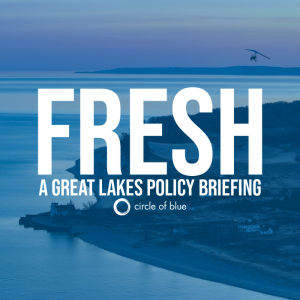Federal Water Tap, November 13: EPA Takes Next Step in Nitrate Health Assessment
The Rundown
- EPA’s health assessment division releases protocol for evaluating nitrate in drinking water.
- EPA orders Minnesota to respond to nitrate pollution of groundwater in the state’s southeast.
- The White House updates guidance for calculating costs and benefits of federal regulation.
- GAO reports on non-native mussels in the Columbia River basin and salmon health in Puget Sound.
And lastly, federal energy regulators examine electric grid reliability.
“Our job is not to push back against the ocean and pretend that these changes are not taking place. Rather, our job is to adapt regulations to them, to ensure reliability and protect customers along the way.” — Allison Clements, commissioner of the Federal Energy Regulatory Commission, discussing FERC’s responsibility in responding to new challenges like climate change and extreme weather, cybersecurity, the addition of more solar and wind to the grid. Clements said this on November 9 at FERC’s annual Reliability Technical Conference, which can be streamed here. FERC also released a report on power outages during a severe storm last December. More on that below.
By the Numbers
200: Number of “underserved” communities that the EPA will assist in identifying, planning, and removing lead drinking water pipes as part of its Get the Lead Out initiative.
News Briefs
Minnesota Nitrate Order
The EPA ordered Minnesota regulators to take immediate action to protect more than 9,000 residents in the state’s southeast region from nitrate in drinking water at levels above the federal limit.
The order from EPA Region 5 administrator Debra Shore covers eight counties with high nitrate levels in groundwater used as a source of drinking water. It directs Minnesota agencies to “to identify, contact, conduct drinking water testing and offer alternate water to all impacted persons” in the region. It also asks for a long-term plan for reducing nitrate levels in drinking water.
Nitrate contamination in the area is largely a result of fertilizer use and manure disposal from farms.
The agency was acting on an April 24, 2023, petition from environmental and public interest groups.
In context: U.S. Regulators Order Minnesota to Clean Up Nitrate Contaminated Water
Revising the Math Behind Federal Regulations
The White House finalized substantial changes to the regulatory process.
Known as Circular A-4, the document instructs federal agencies on how to calculate the costs and benefits of proposed rules.
The revision allows agencies to expand the scope of their analysis outside of U.S. borders. It also reduces the discount rate from 3 percent to 2 percent. This has the effect of bringing present and future values closer together. The discount rate will be revised every three years.
Agencies, at their discretion, can consider how costs and benefits will be distributed within a group — whether some people bear more of a burden, financially or environmentally.
Experts at George Washington University’s Regulatory Studies Center call it the biggest adjustment to regulatory analysis in three decades. The center released this detailed comparison of the draft and final versions.
Studies and Reports
Nitrate Assessment Protocol
The EPA’s health assessment division, known as IRIS, outlined the methods it will use as it evaluates the human health impacts of nitrate in food and drinking water.
Shelved during the Trump administration, the nitrate assessment was restarted this summer. The assessment will examine cancer as well as effects on the cardiovascular system, endocrine system, reproductive system, fetal development, blood, metabolism, liver, and nervous system.
The assessment was requested by the EPA Office of Water, Office of Children’s Health Protection, and Region 5.
In context: EPA Restarts Assessment of Health Risks from Nitrate in Water
Winter Storm Elliott Power Outages
FERC released a staff report assessing power generation failures during six-day Winter Storm Elliott, which pushed across the central and eastern U.S. in December 2022.
The storm walloped the power sector, taking offline some 90,500 megawatts of generating capacity in the Eastern Interconnection, equivalent to 13 percent of total capacity. The Eastern Interconnection stretches across 37 states and three Canadian provinces.
Equipment malfunctioned in the cold weather. Natural gas units struggled with the delivery of fuel supply.
Puget Sound Salmon
To keep salmon from dying in degraded waters, Congress should consider revising the Clean Water Act to give the EPA more authority to limit pollution from diffuse, “nonpoint” sources like farm runoff.
That’s the high-level recommendation in a Government Accountability Office report on threats to salmon in Puget Sound. The watchdog agency offered the same recommendation a decade ago.
Short of congressional action, the report suggests that the EPA work more closely with the Washington State Department of Ecology to assess and identify impaired waters. The state agency missed recent deadlines to do so.
The EPA announced earlier this month that it would take a closer look at the tire ingredient 6PPD, a chemical that degrades into a compound that enters streams and kills salmon.
‘Don’t Move a Mussel’
The GAO also released a report on how the Army Corps of Engineers can prevent quagga and zebra mussels from spreading into the Columbia River basin.
The report, like many GAO findings, recommends better state and federal agency coordination. Transported between basins on boats, the mussels can clog public infrastructure like water intakes.
On the Radar
House Water Bill Hearing
On November 14, a House Natural Resources subcommittee will discuss four water-related bills.
They are: Southwestern Power Administration Fund Establishment Act, Water Data Improvement Act, Urban Canal Modernization Act, and Modernizing Access to Our Public Waters Act.
Federal Water Tap is a weekly digest spotting trends in U.S. government water policy. To get more water news, follow Circle of Blue on Twitter and sign up for our newsletter.
Brett writes about agriculture, energy, infrastructure, and the politics and economics of water in the United States. He also writes the Federal Water Tap, Circle of Blue’s weekly digest of U.S. government water news. He is the winner of two Society of Environmental Journalists reporting awards, one of the top honors in American environmental journalism: first place for explanatory reporting for a series on septic system pollution in the United States(2016) and third place for beat reporting in a small market (2014). He received the Sierra Club’s Distinguished Service Award in 2018. Brett lives in Seattle, where he hikes the mountains and bakes pies. Contact Brett Walton






Leave a Reply
Want to join the discussion?Feel free to contribute!